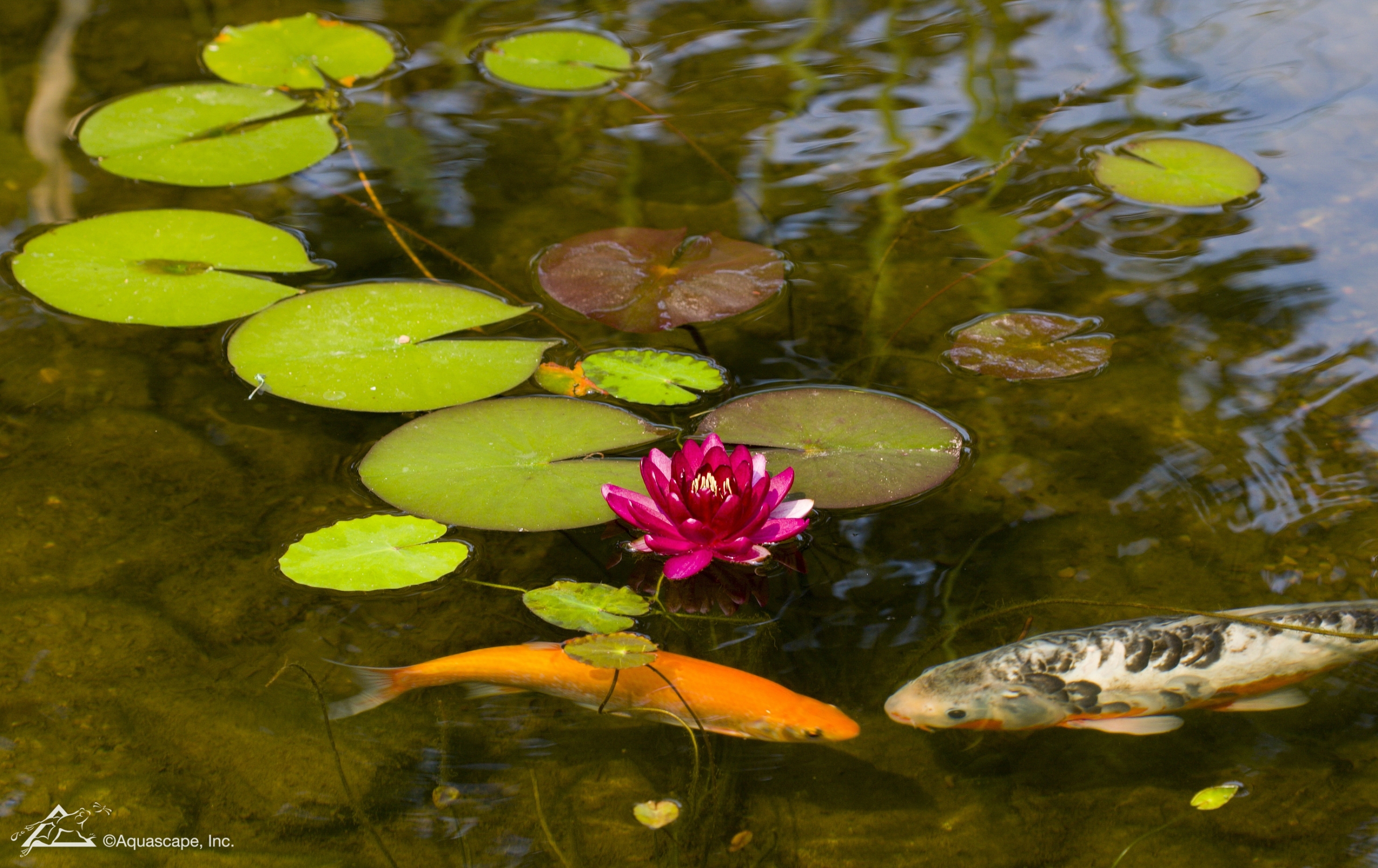[av_two_third first min_height=” vertical_alignment=” space=” custom_margin=” margin=’0px’ row_boxshadow=” row_boxshadow_color=” row_boxshadow_width=’10’ link=” linktarget=” link_hover=” title_attr=” alt_attr=” padding=’0px’ highlight=” highlight_size=” border=” border_color=” radius=’0px’ column_boxshadow=” column_boxshadow_color=” column_boxshadow_width=’10’ background=’bg_color’ background_color=” background_gradient_color1=” background_gradient_color2=” background_gradient_direction=’vertical’ src=” background_position=’top left’ background_repeat=’no-repeat’ animation=” mobile_breaking=” mobile_display=” av_uid=’av-15au1n2′]
[av_textblock size=” font_color=” color=” av-medium-font-size=” av-small-font-size=” av-mini-font-size=” av_uid=’av-kuetnp7o’ custom_class=” admin_preview_bg=”]
There are several varieties of fish that can live quite happily in your backyard pond. Some provide beautiful colors, others interesting behavior. This article will tell you about the best types of fish to get, how many of each type you need, and what they like to eat.
The Best Fish For Your Pond
There is debate as to what fish make the best pets for backyard ponds, but currently, the most popular pet pond fish are goldfish and koi. The easiest type of fish you can grow is called a top minnow. Goldfish and top minnows prefer cooler water than many other kinds of pond fish, which means that they can survive in shallower water. This makes them the best fish for small ponds.
Top Minnows
Top minnows are very easy to care for. They live mostly on the pond’s surface, sifting through water with their mouths for bugs and tiny pieces of food. You can feed them commercial fish food or let them eat bugs out of your pond.
Goldfish
A goldfish is actually a type of carp, one of the oldest domesticated animals in human history.
A lot of people like goldfish because they are beautiful and simple to care for. They eat much less than koi, so they don’t grow as large. They can stand cooler temperatures than other pond fish, such as koi or perch.
Koi
A koi is a type of carp that can grow to be very large and has been bred for color. Koi have changed quite a bit from their natural ancestor, the Prussian carp, which only grows about thirty centimeters long. Because they are so different from most other fish, koi need different conditions from other pond fish. They prefer warmer temperatures and a deep pond with many nooks and crannies to explore.
How Many Fish You Need To Keep In Your Pond
You should keep one goldfish for every ten gallons of water in your pond. So a 100-gallon pond needs 10 goldfish, a 1000-gallon pond needs 100 goldfish, etcetera.
You can keep two or three koi in a thousand-gallon pond, but only put one inch of koi per thirty gallons of water in your pond.
In general, you should only add new fish to your garden after the old ones have been there for at least six months. This will make sure the water quality is stable for your fish.
What Fish Eat
Your fish will mostly eat bugs and small pieces of food they can find floating in the pond, like algae or insects that fall into the water. You may also feed them commercial fish food once per day. Koi eat tiny animals like insect larvae, plankton, snails, and even very small fish. These are usually too small to see by the human eye without magnification. Koi also eat plants from time to time if their usual sources of food are scarce due to temperature changes or other factors. Top minnows eat whatever floats down to them on the pond’s surface. In general, top minnows don’t need special diets.
How To Feed Your Fish
Goldfish and top minnows can only eat floating foods, so they need to eat at the surface. Koi can also get their food from plants and muddy bottoms, so you don’t have to worry about feeding them as often if your pond has lots of plants or natural sources of food for them.
If you want to give your fish commercial fish food, use a long-handled net to feed your fish. This makes sure that none gets left behind in the bottom and pollutes your pond. Or, put a few flakes or pellets in your hand and let them eat it off of your palm. Feeding fish too much food is bad for the water quality, especially if you feed them a lot of protein-rich foods like insects.
Plants help keep the water quality up by absorbing some of the fish’s waste and excess food, so it’s a good idea to have lots of plants around your garden pond.
Different Fish Like Different Kinds Of Plants
Koi love to eat string algae, which can grow really fast in your pond in spring or fall. They don’t bother most other plants in the pond.
Goldfish are not picky about what they eat, so you can put any kind of plant around your pond. However, some fish are known to nibble on leaves if there is nothing else for them to eat. You may keep your goldfish secure by surrounding the perimeter of your pond with chicken wire or another form of mesh that prevents fish and turtles from escaping but allows insects to pass through.
[/av_textblock]
[/av_two_third][av_one_third min_height=” vertical_alignment=” space=” custom_margin=” margin=’0px’ row_boxshadow=” row_boxshadow_color=” row_boxshadow_width=’10’ link=” linktarget=” link_hover=” title_attr=” alt_attr=” padding=’0px’ highlight=” highlight_size=” border=” border_color=” radius=’0px’ column_boxshadow=” column_boxshadow_color=” column_boxshadow_width=’10’ background=’bg_color’ background_color=” background_gradient_color1=” background_gradient_color2=” background_gradient_direction=’vertical’ src=” background_position=’top left’ background_repeat=’no-repeat’ animation=” mobile_breaking=” mobile_display=” av_uid=’av-tikjym’]
[av_image src=’https://aquascapes.com/wp-content/uploads/2018/06/Fish_03-300×225.jpg’ attachment=’8424′ attachment_size=’medium’ align=’center’ styling=” hover=” link=” target=” caption=” font_size=” appearance=” overlay_opacity=’0.4′ overlay_color=’#000000′ overlay_text_color=’#ffffff’ copyright=” animation=’no-animation’ av_uid=’av-kuetskpa’ custom_class=” admin_preview_bg=”][/av_image]
[av_image src=’https://aquascapes.com/wp-content/uploads/2018/06/Fish_02-300×189.jpg’ attachment=’8438′ attachment_size=’medium’ align=’center’ styling=” hover=” link=” target=” caption=” font_size=” appearance=” overlay_opacity=’0.4′ overlay_color=’#000000′ overlay_text_color=’#ffffff’ copyright=” animation=’no-animation’ av_uid=’av-kuetv54s’ custom_class=” admin_preview_bg=”][/av_image]
[av_image src=’https://aquascapes.com/wp-content/uploads/2018/05/Turtle_01-300×200.jpg’ attachment=’8315′ attachment_size=’medium’ align=’center’ styling=” hover=” link=” target=” caption=” font_size=” appearance=” overlay_opacity=’0.4′ overlay_color=’#000000′ overlay_text_color=’#ffffff’ copyright=” animation=’no-animation’ av_uid=’av-kuetx33r’ custom_class=” admin_preview_bg=”][/av_image]
[av_image src=’https://aquascapes.com/wp-content/uploads/2018/06/Fish_08-300×200.jpg’ attachment=’8440′ attachment_size=’medium’ align=’center’ styling=” hover=” link=” target=” caption=” font_size=” appearance=” overlay_opacity=’0.4′ overlay_color=’#000000′ overlay_text_color=’#ffffff’ copyright=” animation=’no-animation’ av_uid=’av-kueu2sol’ custom_class=” admin_preview_bg=”][/av_image]
[/av_one_third]

